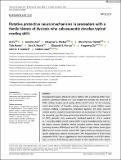Notice
This is not the latest version of this item. The latest version can be found at:https://dspace.mit.edu/handle/1721.1/130434.2
Putative protective neural mechanisms in prereaders with a family history of dyslexia who subsequently develop typical reading skills
Author(s)
Yu, Xi; Zuk, Jennifer; Perdue, Meaghan V.; Ozernov-Palchik, Ola; Raney, Talia; Beach, Sara Dawley; Norton, Elizabeth S.; Ou, Yangming; Gabrieli, John D. E.; Gaab, Nadine; ... Show more Show less
DownloadPublished version (2.272Mb)
Publisher with Creative Commons License
Publisher with Creative Commons License
Creative Commons Attribution
Terms of use
Metadata
Show full item recordAbstract
Human Brain Mapping published by Wiley Periodicals, Inc. Developmental dyslexia affects 40–60% of children with a familial risk (FHD+) compared to a general prevalence of 5–10%. Despite the increased risk, about half of FHD+ children develop typical reading abilities (FHD+Typical). Yet the underlying neural characteristics of favorable reading outcomes in at-risk children remain unknown. Utilizing a retrospective, longitudinal approach, this study examined whether putative protective neural mechanisms can be observed in FHD+Typical at the prereading stage. Functional and structural brain characteristics were examined in 47 FHD+ prereaders who subsequently developed typical (n = 35) or impaired (n = 12) reading abilities and 34 controls (FHD−Typical). Searchlight-based multivariate pattern analyses identified distinct activation patterns during phonological processing between FHD+Typical and FHD−Typical in right inferior frontal gyrus (RIFG) and left temporo-parietal cortex (LTPC) regions. Follow-up analyses on group-specific classification patterns demonstrated LTPC hypoactivation in FHD+Typical compared to FHD−Typical, suggesting this neural characteristic as an FHD+ phenotype. In contrast, RIFG showed hyperactivation in FHD+Typical than FHD−Typical, and its activation pattern was positively correlated with subsequent reading abilities in FHD+ but not controls (FHD−Typical). RIFG hyperactivation in FHD+Typical was further associated with increased interhemispheric functional and structural connectivity. These results suggest that some protective neural mechanisms are already established in FHD+Typical prereaders supporting their typical reading development.
Date issued
2020-03Department
McGovern Institute for Brain Research at MITJournal
Human Brain Mapping
Publisher
Wiley
Citation
Yu, Xi et al. "Putative protective neural mechanisms in prereaders with a family history of dyslexia who subsequently develop typical reading skills." Human Brain Mapping 41, 10 (March 2020): 2827-2845 © 2020 The Authors
Version: Final published version
ISSN
1065-9471
1097-0193